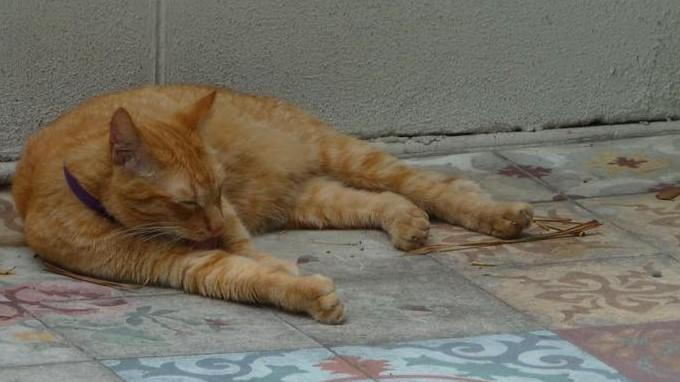Why Do Cats Scratch?

- posted: Feb. 07, 2020
Why Do Cats Scratch?
Cats have a natural instinct to scratch. But why do they like to shred our furniture or make grooves in our door jambs? Let’s explore why cats have the urge to sharpen their claws and how we can help them channel their natural instincts so they can peacefully coexist in our homes.
The instinct to scratch is deeply ingrained in our feline friends. The purpose of scratching is threefold:
- Scratching on a surface such as a log or scratching post allows cats to sharpen their nails to catch prey and to remove dead bits of toenail, similar to when we trim our own nails. Even though our indoor cats don’t need to catch prey, the urge to sharpen their claws is instinctual and helps them to maintain their manicures and keep claws in good shape.
- Scratching on surfaces is also a way to mark territory and leave scent cues behind. Cats have glands in their paw pads that leave behind a scent for other cats to alert them that they may be straying into one cat’s territory. Indoor cats may try to mark furniture to establish territory shared by other cats or even mark places where their humans sit.
- Scratching also allows cats to exercise, stretch the muscles in their legs and feet and may also help relieve anxiety. Indoor kitties typically have reduced activity so scratching provides a way to keep fit and relieve stress.
Scratching, while natural and beneficial to our feline friends, can be destructive if cats are not taught how to use an acceptable outlet for the behavior and can damage the human-animal bond we have with our cats.
No one wants cats shredding their new couch or literally climbing the walls. But we can’t expect cats to suppress innate instincts without some guidance from us. Cats can be taught to sharpen claws on specific surfaces like scratching posts or pads. This works best in young kittens during their socialization and learning period when they are approximately 9-14 weeks of age, but older kittens and cats can still be taught to scratch specific areas.
To teach a cat to use a scratching post or pad, it may be best to provide both vertical and horizontal scratching posts/pads. Offering different surfaces can be helpful as well—sisal/rope, carpet, corrugated cardboard, or wood are all good options and it may be necessary to offer variety to determine what personal preferences your cat has.
If your cat is already scratching a favorite couch or baseboard, try to mimic the type of surface to which he is attracted and place the scratching post next to the object your cat is already clawing. For instance, if your kitty is scratching the side of a fabric covered chair, find a vertical scratching post covered with carpet or fabric and place next the chair.
Attractants such as catnip, or products like Feliway brand Feliscratch can encourage kitty to scratch the desired object as opposed to scratching walls or curtains. Rewarding your cat with a small food treat when she uses the designated scratching post can also help encourage the behavior. Try to avoid negative or physical punishment, but placing aluminum foil or double-sided sticky tape on areas where you don’t want your cat to scratch can discourage unwanted scratching.
Keeping nails trimmed short and using nail caps such as SoftPaws can also reduce unwanted scratching. Declawing cats remains controversial and the AVMA no longer recommends this practice as it causes pain and may lead to other behavior problems in cats.
If your cat is scratching areas he shouldn’t and/or you are having difficulty teaching your cat to use a scratching post, contact your veterinarian to talk through options to keep you and your cat living peacefully together.
This blog brought to you by the Patton Veterinary Hospital serving Red Lion, York and the surrounding communities.
Location
Patton Veterinary Hospital
425 E Broadway
Red Lion, PA 17356
